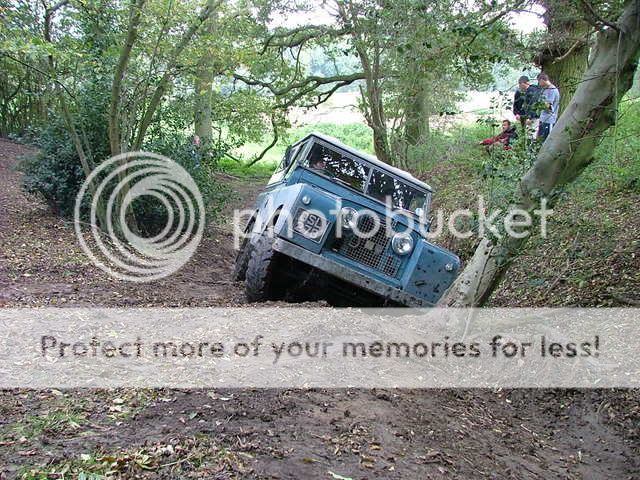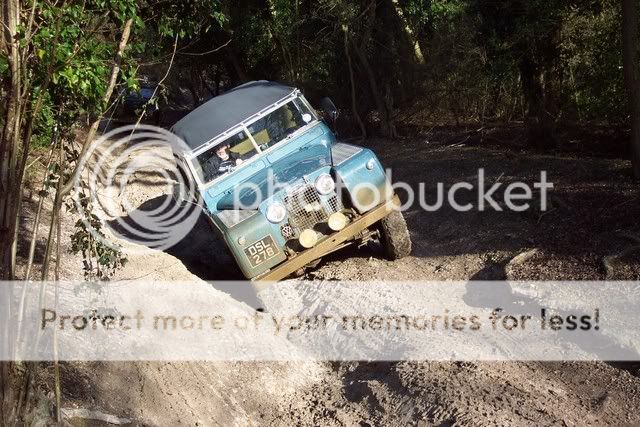OK, spring 'oiling'... those that have advocated the practice aint going to like this, BUT:-
'plain' leafs have the strips of spring steel rubbing on one another. That rubbing provides a very crude form of damping through friction, but subject to a phenomina known as 'stiction'.
This is like trying to shove a washing machine accross your kitchen floor; give it a shove and it doesn't want to move, there is a very high friction force between the washing machione and the lino on the floor. But as SOON as the washing machine starts moving, it slides pretty easily, the friction force reducing as soon as you have over come the 'stiction'...
Make sense?
Right; the frictioon between the leaves in your plain leaf spring do exactly the same thing, they dont want to budge until they get a big bump force to make them shift, then they compress like crazy.......
Now, conveniently, oil stirrer dampers have a very poor response curve. They are a piston in a pot of oil, and when they start moving, instead of the piston moving through the oil giving a progressive damping action.... the piston just shoves the oil above the piston up the cylinder. As it does so, it compresses the air-gap and that eventually builds up enough pressure to shove the oil past the piston, and you get some damping force from the darn thing.
So, oil-damper on plain leaf, the LACK of response from the damper goes some way to compensating for the fact that you have a huge 'stiction' force to overcome before you get any movement...... but its a bit hit and miss, and how much travel you need before the stiction is over come and before the damper starts working is dependent on a huge range of things, and can vary while you are on the move......
You say your leaf clamps are starting to come apart.... this suggests that you have a lot of rust building up between the leaves. This means that if they aren't siezed almost solid, there will be a lot more stiction, becouse of the higher clamping force between the leafs from having all that 'crud' between them.
As suggestion, stripping rusted plain leafs and wire-brushing them WILL make a big difference..... first of all the leafs will be 'free' to rub against one another like they should have to begin with.
Next, they will also be thinner.... that rust had to come fom somewhere.... and it used to be metal in the spring!
Thinner leafs means that they wont be as 'stiff' as if they were new, which means they are more 'giving'..... and they also wont be clamped together so hard, so there will be less friction damping and stiction.
But also, becouse you dont tend to hammer the axles against the bump stops on every bump, the spring is likely to have developed a 'wear pattern' over the range its most often compressed through.
This means that it will probably be softer in that region as the leafs in that wear zone are thinner, but also there is likely to be a ridge or ramp at the end of that zone, where less rubbed, to 'snag' the leaves and drastically change the spring rate over a very small range of travel, which may be a LITTLE aleviated by cleaning them up and making the leaves a bit smoother.
So far so good; The old, but cleaned springs will feel a lot better, becouse they first actually working, and second, softer than standard.
But, they will be weaker, and if the stress of being seperated by lamena rust in the stack hasn't distorted them or fatigued them, they still wont have much life in them (but possibly enough..... they have probably lasted best part of forty years, cleaned up you may get another five out of them) If they HAVE been stressed or fatgued in the stack, then when you strip them you may find that a leaf or two are allready cracked if not actually broken. If not, there is little garantee, that asked to work for a living again, they wont break fairly soon.
Either way, chances are that once fettled, the body wont settle level on the cleaned springs, or if it does, it will probably ride a little lower than it should.
But, if funds are tight, all it costs is time and effort.
As for oiling....... well that does little except lubricate the leafs against rubbing... it wont eliminate stiction, but it will reduce it..... a little.
The price however is that whatever you lube the leafs with, will trap road crud, and that will act as a good 'lapping paste' so that as the, now thinner leaves' rub, they will also grind each other even thinner.....
Wrapping the leaves in chamois leather soaked in oil used to be a common suggestion and was considered a 'high-class' tip having been done by the Bentley boys to thier Le-Mans cars back in the 1920's.
The leather holds the oil in around the leaf, and offers some protection against grit getting in to act as a grinding past. The leather, mean-while, ALSO acts as a very crude, but quite effective 'hydraulic' damper, if wrapped tight enough, not effected by the 'lag' of a telescopic strut.
It worked, notionally well by 1920's standards, but doesn't last very well, the leather breaks down quite quickly, and needs renewing to keep it effective.
Modern variations on the principle involve copper slip or similar, and plastic bags........ old rags and variouse other notions or potions!
Again, bottom line is, if you dont have the dosh, it can be useful, and only costs you your time and effort.
But fundementally, you are not tackling the real issue, which is that you have clapped out old springs!
So, to fix it 'properly' you have a choice, buy new plain leafs, or upgrade to parabolics.
New leafs, SHOULD work pretty smoothly, they wont have wear ridges in them, the shape should be right, the rate should be right, and when fitted up, the body should ride level and even at the correct ride hight.
Then in operation, after they have 'bedded in' a bit, they should give a reasonably progressive and complient ride through the full range of travel.
Fit them up with new bushes, and new oil stirrer dampers, and the ride should be pretty much as was expected by the factory when the car was built, and SHOULD last another twenty years without major degredation.
IF the replacement springs are of equal quality to the originals..... but Brit-Part,(and similar 'cheap' spings) and rumour has it they are so poorly tempered, that they can start to 'say' on your drive, in as little as a couple of months!
So, parabolics; they dont suffer from stiction, and have a greater amount of travel and a more controlled 'rate', which means that they actually offer complience more proportinally to the bump force... ie they actually work on smaller and middle sized bumps, not needing such a huge force to get them moving, and so give a much less 'harsh' ride. But as said, they are best matched to a gas damper that doesn't suffer the 'lag' problem of an oil-stirrer to get the most benefit from them.
The parabolic concept unfortunately started to gain acceptance at about the time leaf-springs were generally being deemed 'old fasioned' and fitted purely for ecconomic reasons, where the added cost of a parabolic just wasn't wanted, except in a few instances, where it was cheaper to use a para than developing a new tortion bar or coil spring suspension system.
As was the case with the Santana Series III+'1/2' Land-Rover, for which Paul Haystee did all the resaerch work in the late 1970's, to develop the springs the Spaniards went on to use after Solihul dismissed it by the expedience of using the Range rover coils, and Chris Perfect was to flog for many years in this country, for a rather uncompetative price.
Meanwhile in the USA, where leaf-springs were far less unfasionable, parabolics were a common upgrade, either by the OE manufacturers or as an after-market accessory, and Rocky-Mountain created thier range of springs from what was on offer that side of the pond.
Now both of those 'makes' are 'top-end' products and are quite exhorbitantly priced. Hoever, for your money you get a spring made to a very exacting standard that is not only of a superior design, but also a superior quality to the OE fit plain leafs, and likely to last as long or longer than such springs, even under hard use.......
The 'British Springs' parabolic is ALMOST as good for manufactuiring quality, and from conversations I've had with Paul Haystee, the only 'copy' of 'his' spring (as he reffers to them!) that is actually a 'genuine' parabolic, rather than what he calls a "tapered and seperated 'plain' leaf stack" Which is to depart into an area of engineering symantics over the defanition of a 'parabolic' spring, which is pretty irrelevant to most of you.
Practically, Santana / Rocky / British Paras, are 'premium' springs, that will do the job and will last a long time. There are differences and depending on your selection, opinion suggests that CP/Santana springs offer more complience for off-roading, particularly on standard matalastic bushes, rather than poly-blocks, but at the expense of some on road manners; they give a little more 'roll' and 'pitch'. British are the other way it seems, and a little better on the road with more pitch and roll resistance, but slightly less complient off-road; Rockies, I believe are some-where between, and would seem a reasonable compromise..... though a LOT depends on the actual spring you select for your vehicle, as they do offer different rates in all brands....... and ULTIMATELY the dampers you choose to match them with will also influence the way the car behaves.
In the realms of the 'budget' parabolics, cost cutting can come in many ways, but as Paul pointed out, the very cheapest paras dont actually have a propper parabolic taper, they have a liniar taper...... but practically that doesn't make much odds to many customers.... they have pretty much the same properties as a genuine parabolic taper leaf, work in the same way, giving a more complient ride over a wider range of travel.
Only noticeable difference is that they tend to lack the sphisticated tempering treatments of the 'top' brands and consequently dont last as long...... perhaps ten to fifteen years instead of twenty to thirty........ but at half the price? Doesn't mean they are bad value.
As said, you pays your money and takes your choice; what is 'best' really depends on what you are hoping for.
Parabolics DO have a lot to offer, but it depends on the compromise; get the wrong paras and match them with the wrong dampers and you could have something that costs you a lot of money and doesn't work very well; conversely, get it 'right' with decent plain leafs and dampers, you may be very happy with them....
I spent around £300 on my Parabolic set up, I was very pleased with it, and for the service I got out of it, and the value selling it on, I reckon I got my money's worth.... it all depends on what is important to you.
The things to beware of are false ecconomies; IF you are stripping your springs, then is it REALLY worth all that time and effort JUST for a couple more years service with compromised performance? IF you go 'top end' and go for a top-brand para and matching damper, are you REALLY going to get the benefit of it, either through the better 'action' and/or life of the set up? In the middle, are you going to be able to get something 'adequete' by way of life and performance and cost, and NOT be dissapointed?
It ALL depends on what your expectations are, and your means.







